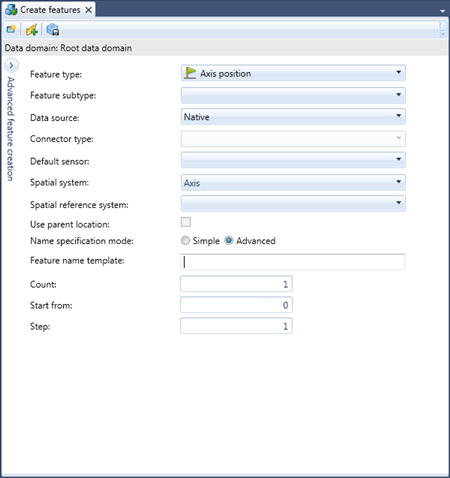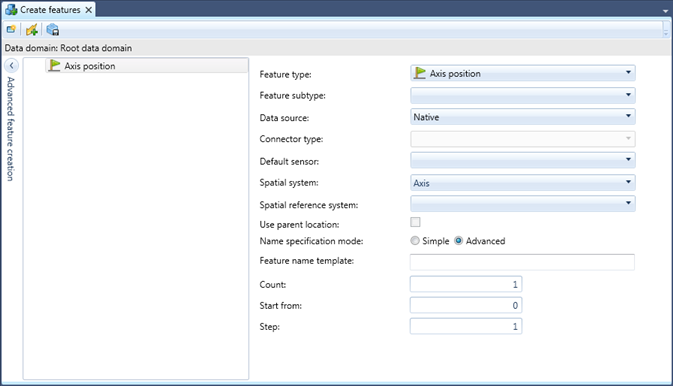

The Create Features window is a document window used to create new features in a specific domain.
The window can be opened from the Ribbon's Content tab, from the context menu of a domain in the Domain Explorer's domain tree, from the context menu of a feature type in the Domain Explorer's context tree, and from the context menu of a feature subtype in the Data Domain Explorer's context tree.
You can open any number of feature creation windows at the same time.
All features created from one instance of the Create Features window will be created in the same domain. When opened from the Ribbon and when no focus domain is set you will first be asked to specify that domain. When opened opened from the Data Domain Explorer, from a node in the Data Domain Context or when opening from the ribbon with a focus domain set the appropriate domain is automatically set.
The window can be operated in two different modes: Simple mode and Expert mode. The simple mode will be sufficient for many uses and will ask the user only for the most important information for creating new features. The expert mode gives you the possibility to define many advance options for the creation of new features. You can switch between simple and expert mode using the Expert mode command button in the window's toolbar.
Features are created according to a feature creation model that you define in this window. In the simplest case the feature creation model is just the specification of a few basic characteristics of the features to be created, however you can also define more complicated creation models in this window that may create multiple features of different feature types and can also specify a platform relation between the newly created features. The feature creation model you define in this window can be persisted as a Feature Creation Template that can be reused later for a faster creation of features.
A feature creation model contains one or more feature creation specifications. Each feature creation specification defines the characteristics of features that will be created from that specification. The feature creation model defines the domain for all features and the platform relation that will be build between the features created from different feature creation specifications.
After you created features from this model (i.e. after you executed the feature creation model) the newly created features will be automatically added to the Feature Selection (if you have the right to list the feature).
Table 1 shows the characteristics that can or must be specified with each feature creation specification.
Characteristic |
Description |
Feature type |
Mandatory. The feature type of the features created from this specification. Only feature types that are available in the selected domain and that are licensed will be available in this list. |
Feature name specification |
Mandatory. Specification of one or more feature names. Names can be directly specified you can use text templates and you can use a loop mode to create many features at the same time. |
Feature subtype |
Optional. The feature subtype for the features created from this specification. Only subtypes available in the current domain will be shown. |
Data source |
Mandatory (Default is Native). The data source for the created features. |
Connector type |
Mandatory if data source is Connector. If the data source is set to connector the connector type must be specified. |
Default sensor |
Optional. The sensor that will be set as default sensor for all features created from this specification. |
Spatial system type |
Optional. The spatial system type the newly created features shall use. |
Spatial reference system |
Mandatory if a spatial system type was specified. The spatial reference system. Here you can select one of the spatial reference systems that are available in the current domain. |
Use relative location |
If set defines that the features' spatial location shape and orientation is given relative to the container feature (if any) |
Instance specification |
Mandatory. Defines the number of features to be created from this specification and the names of these features. Redbex supports two different types of instance specifications. Name list: A simple list of feature names. |
Table 1: Characteristics that are defined in a feature creation specification.
Instance specification
Two types of instance specifications are supported: Name list and Iterated. A name list is a simple list of names of features to be created. The names given here are text templates. Table 2 lists the additional text template variables available in this context. The iterated instance specification allows you to specify an iterator variable (start value, step) and a count of features to be created. The name template is again a text template with the variables shown in table 2 but with the additional variable {{index}} that contains the iterator variable value.
Variable |
Description |
featuretype |
Name of the feature type of the features to be created by the current creation specification. |
featuresubtype |
Name of the feature subtype of the features to be created by the current creation specification. |
parentfeaturetype |
The feature type of the parent feature if the feature creation specification creates features in a parent platform feature. |
parentfeaturesubtype |
The feature subtype of the parent feature if the feature creation specification creates features in a parent platform feature. |
Table 2: Text template variables additionally available with the instance specification

Figure 1: The Create features window shown in simple mode.

Figure 1: The Create features window shown in advanced mode.
